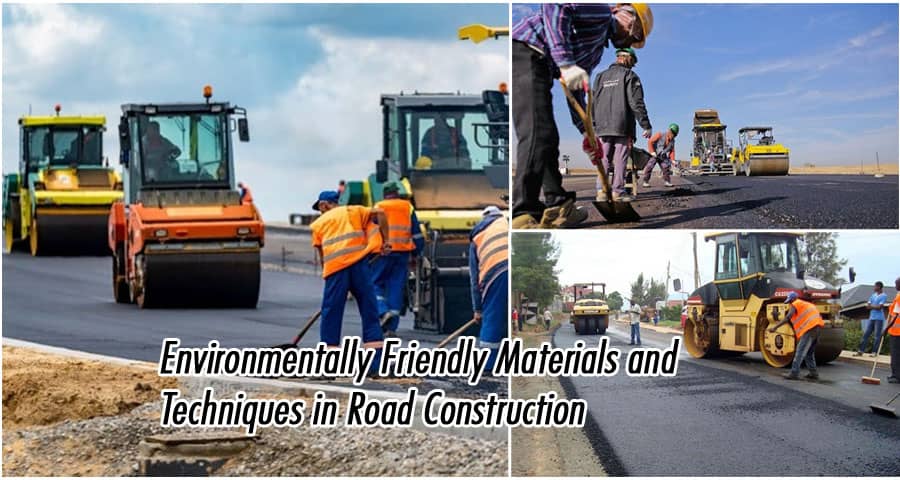The Use of Environmentally Friendly Materials and Techniques in Road Construction

In today's rapidly evolving world, addressing environmental concerns is paramount. As we navigate the challenges of climate change and diminishing natural resources, it's crucial to reevaluate our conventional practices and explore more sustainable alternatives. One area where this shift is gaining traction is in road construction.
Traditional Road Construction Methods
Traditional road construction techniques, characterized by the extensive use of non-renewable resources, can have a severe impact on the environment. The extraction and processing of materials like asphalt and concrete contribute to carbon emissions and resource depletion. Additionally, the construction process often disrupts ecosystems and harms local communities.
Environmentally Friendly Road Construction Techniques
- Utilizing Recycled Materials: One way to mitigate the environmental impact is by recycling materials like asphalt and concrete. Reusing these resources reduces the need for virgin materials and lowers emissions.
- Sustainable Pavement Design: Innovative pavement designs are being developed to increase durability and reduce maintenance requirements, resulting in less resource consumption.
- Green Binders: Environmentally friendly binders, such as bio-based or recycled binders, offer a sustainable alternative to traditional asphalt.
- Vegetated Roadways: Implementing vegetated or green roadways can reduce water runoff and improve air quality.
Benefits of Using Environmentally Friendly Materials
The use of environmentally friendly materials and techniques in road construction brings numerous benefits. These include a reduction in greenhouse gas emissions, less strain on natural resources, and cost savings in the long term. Communities benefit from improved air quality and reduced noise pollution.
Case Studies
To illustrate the real-world impact of eco-friendly road construction, let's explore a couple of noteworthy case studies.
- The Solar Road in the Netherlands: This innovative project integrates solar panels into the road surface, providing renewable energy and reducing the carbon footprint.
- The Plastic Roads in India: India has experimented with plastic waste in road construction, offering a unique solution to both waste management and sustainable infrastructure development.
Challenges and Limitations
While the shift towards eco-friendly road construction is promising, there are challenges to overcome. These include initial cost barriers, the availability of sustainable materials, and the need for additional research and development.
Future Trends
The future of environmentally friendly road construction is exciting. It involves further advancements in sustainable materials, the integration of smart technologies, and greater community involvement in project planning.
Government Initiatives and Regulations
Governments worldwide are enacting policies and regulations to promote environmentally friendly road construction. These measures aim to incentivize sustainable practices and reduce the environmental impact of infrastructure development.
Cost Considerations
While initial costs for eco-friendly road construction may be higher, the long-term economic benefits are significant. Reduced maintenance and repair expenses, as well as positive impacts on public health, make it a viable and cost-effective option.
Community Engagement
Engaging local communities in the planning and decision-making processes for road construction projects fosters a sense of ownership and ensures that projects align with community needs and values.
The Role of Technology
Innovations in technology, such as 3D printing and advanced construction equipment, are revolutionizing road construction. These technologies increase efficiency, reduce waste, and enhance safety.
Materials of the Future
Materials like self-healing concrete and sustainable aggregates are emerging as critical components of eco-friendly road construction. Their durability and environmental benefits make them promising choices.
Environmental Impact Assessment
A thorough environmental impact assessment is essential to measure the positive effects of eco-friendly road construction on local ecosystems and communities.
Public Awareness and Education
Promoting awareness of the benefits of environmentally friendly road construction is key to its success. Educating the public about reduced pollution, enhanced quality of life, and cost savings encourages support for these initiatives.
Conclusion
The adoption of environmentally friendly materials and techniques in road construction is a pivotal step towards a sustainable future. By reducing environmental harm, improving community well-being, and enhancing economic viability, eco-conscious road construction paves the way for a better tomorrow.
FAQs
Is environmentally friendly road construction more expensive than traditional methods?
Initially, it may have a higher upfront cost, but the long-term savings and benefits outweigh the initial investment.
What are some common sustainable materials used in road construction?
Sustainable materials include recycled asphalt, bio-based binders, and innovative aggregates.
How can local communities get involved in road construction projects?
Communities can engage in public consultations and participate in project planning to ensure their interests are considered.
What is the role of technology in eco-friendly road construction?
Technology enhances efficiency, reduces waste, and increases safety in road construction projects.
What government policies support environmentally friendly road construction?
Governments around the world are enacting regulations and incentives to promote sustainable road development.
